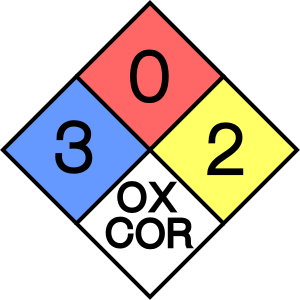HACH LCK114 COD CUVETTE TEST
Basic information
- Chemical formula(s): Contains \({\rm H_2SO_4}\) (sulfuric acid), \({\rm HgSO_4}\) (mercury sulfate), \({\rm K_2Cr_2O_7}\) (potassium dichromate), \({\rm Ag_2SO_4}\) (silver sulfate)
- Other names: LCK114 CSB/COD/DCO Sample cuvette, Chemical Oxygen Demand test kit
- Product Code: LCK114
- Unique Formula Identifier (UFI): QR0A-1FV5-X80X-MANR
- International Chemical Safety Card (ICSC): N/A - multiple components (see Hach safety card)
- Flammability: no
- Description: Sample cuvette for water analysis and determination of Chemical Oxygen Demand (COD). Contains 80-90% sulfuric acid with mercury sulfate, silver sulfate, and potassium dichromate as reagents.
NFPA 704 (fire diamond)

- Health (blue): 3 - short exposure could cause serious temporary or residual injury.
- Flammability (red): 0 - will not burn under typical fire conditions.
- Instability–reactivity (yellow): 2 - undergoes violent chemical change at elevated temperatures and pressures, reacts violently with water.
- Special notice (white): OX, COR - oxidizer and corrosive.
Hazard statements
| Code | Phrase |
|---|---|
| H290 | may be corrosive to metals |
| H302 | harmful if swallowed |
| H311 | toxic in contact with skin |
| H314 | causes severe skin burns and eye damage |
| H318 | causes serious eye damage |
| H332 | harmful if inhaled |
| H340 | may cause genetic defects |
| H350 | may cause cancer |
| H360FD | may damage fertility, may damage the unborn child |
| H373 | may cause damage to organs through prolonged or repeated exposure |
| H410 | very toxic to aquatic life with long lasting effects |
Precautionary statements
| Code | Phrase |
|---|---|
| P201 | obtain special instructions before use |
| P260 | do not breathe dust/fume/gas/mist/vapours/spray |
| P273 | avoid release to the environment |
| P280 | wear protective gloves/protective clothing/eye protection/face protection |
| P303+P361+P353 | IF ON SKIN (or hair): take off immediately all contaminated clothing, rinse skin with water or shower |
| P305+P351+P338 | IF IN EYES: rinse cautiously with water for several minutes, remove contact lenses if present and easy to do, continue rinsing |
| P308+P313 | IF exposed or concerned: get medical advice/attention |
| P310 | immediately call a POISON CENTER or doctor |
| P391 | collect spillage |
| P405 | store locked up |
| P501 | dispose of contents/container in accordance with local regulations |
Protective measures
Gloves
Based on the safety data sheet recommendations for handling strong acids and toxic chemicals:
- Viton™: very good - recommended for long-term contact (>480 minutes breakthrough time, 0.70 mm thickness).
- Nitrile: fair - suitable for short-term contact only (>30 minutes breakthrough time, 0.20 mm thickness).
- Natural latex or rubber: poor (not recommended) - not suitable for acids.
- Neoprene: fair to good - moderate resistance to acids.
Safety goggles
- Always wear chemical safety goggles or face shield when handling this product.
- Corrective glasses are not considered safety goggles.
- Handle only in a fume hood or with appropriate exhaust ventilation.
Clothing
- Wear acid-resistant protective clothing and closed shoes.
- Long sleeves and full-length pants required.
- Contact lenses are forbidden while working with this product.
- Do not wear synthetic clothing that may melt if exposed to acid.
- Remove contaminated clothing immediately and wash before reuse.
Respiratory protection
- Ensure adequate ventilation.
- If exposure limits are exceeded or irritation is experienced, use appropriate respiratory protection.
- Recommended filter type: ABEK-P3 for vapors/dusts/aerosols.
Spill management
- Evacuate personnel to safe areas and ensure adequate ventilation.
- Use full personal protective equipment including acid-resistant gloves and clothing.
- Prevent entry into drains, sewers, or water bodies.
- Neutralize carefully with sodium bicarbonate or lime if safe to do so.
- Absorb with inert material (sand, vermiculite, acid binder).
- Collect in appropriate containers for disposal as hazardous waste.
- Never add water directly to concentrated acid spills.
- Contact emergency services immediately for large spills.
- Dispose according to local hazardous waste regulations.
Special warnings
- Contains mercury compounds - extremely toxic, handle with extreme care.
- Contains chromium(VI) compounds - carcinogenic and mutagenic.
- Reacts violently with water - always add acid to water, never water to acid.
- Restricted to professional users only.
- Store in cool, dry, well-ventilated area away from incompatible materials.
- Keep away from bases, organic materials, reducing agents, and metals.